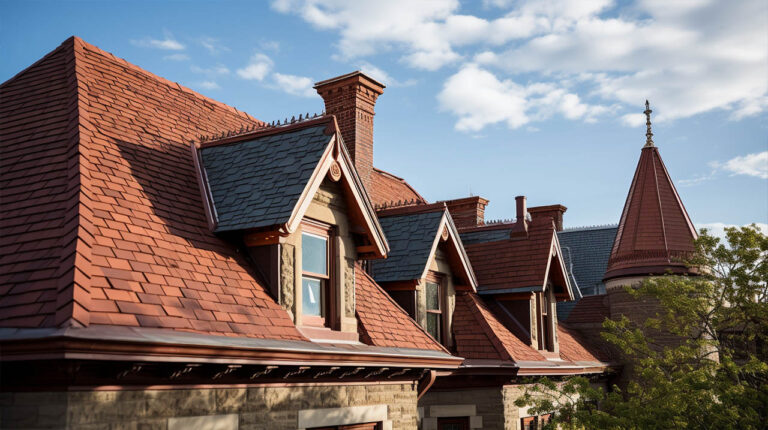Roofs play a pivotal role in safeguarding the structural integrity of any building, especially historic ones. They not only shield the structure from external elements but also contribute significantly to its aesthetic appeal. In this guide, we delve into the importance of preserving the original features of historic roofs and offer best practices to ensure their longevity.
The Significance of Original Roof Features
Historic buildings often boast roofs that are not just functional but also serve as character-defining features. These roofs, designed meticulously, have the primary role of preventing water penetration, which could lead to structural damage. Altering the original configuration can lead to drainage issues, potentially causing moisture damage. Moreover, any significant change can compromise the building’s historic character, impacting the overall appearance of the surrounding area.
At TecHero Roofing, we understand the importance of preserving the originality of these roofs. Our expertise in North Hills roofing ensures that we maintain the integrity of these historic structures while offering modern solutions.
Evolution of Roof Designs and Materials
Historic buildings in Wisconsin, from the early 19th century, predominantly featured hipped or gable roofs. As architectural styles evolved, Mansard roofs, inspired by the Second Empire style, gained popularity between the 1860s and 1880s. Subsequent years witnessed the emergence of various roof forms like gambrel, pyramidal, and conical, among others.
The choice of roofing materials has also seen a transition over the years. While wood shingles, slate, and metal were the primary choices in the early days, the 20th century introduced materials like asphalt, asbestos shingles, cement tile, and clay tile. Despite these advancements, many of Wisconsin’s historic buildings still retain their original roofing materials, testament to their durability and timeless appeal.
The Role of Chimneys in Historic Buildings
Before the advent of modern heating systems, chimneys were integral to most houses. These structures, made of brick or stone, vented smoke from fireplaces or stoves. Over time, as heating systems evolved, the primary function of chimneys changed. However, their architectural significance remained. Many historic houses in Wisconsin feature decorative chimneys that add to their character. At TecHero Roofing, we emphasize the importance of preserving these chimneys, ensuring they remain a testament to the building’s rich history.
Skylights: Merging Functionality with Aesthetics
Skylights have been a prominent feature in many historic commercial buildings, especially those with one or two stories. These structures, often large and made with wood or metal frames, illuminated the building interiors with natural light. If your historic building boasts an original skylight, it’s crucial to preserve it, ensuring it continues to serve as a character-defining feature.
Gutters and Downspouts: The Unsung Protectors
Gutters and downspouts, though primarily utilitarian, play a crucial role in preserving the integrity of historic buildings. These structures ensure proper drainage, preventing potential water damage to roofs, walls, and foundations. Regular inspection and maintenance of these elements are vital to safeguard the building from water-related damages.
Best Practices for Historic Roof Preservation
- Maintain the Original Shape and Features: It’s essential to retain the historic roof’s original size, shape, pitch, and style features. Avoid introducing new elements that might detract from its historic appearance.
- Preserve Chimneys: Even if no longer functional, chimneys serve as significant architectural features. Ensure they are preserved and maintained in their original form.
- Skylight Preservation: If your building has an original skylight, ensure its preservation. If introducing a new skylight, its design should be in harmony with the building’s historic character.
- Regular Maintenance: Regularly inspect and maintain gutters, downspouts, and other roof elements to prevent potential damages.
In conclusion
Preserving the original features of historic roofs is not just about maintaining their functionality but also about honoring the rich history they represent. At TecHero Roofing, our expertise in roof repair in North Hills ensures that we strike the perfect balance between preservation and modernization, ensuring your historic building stands tall for years to come.


